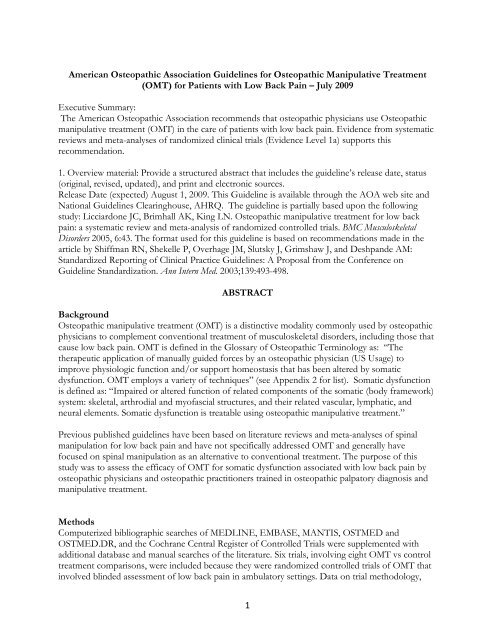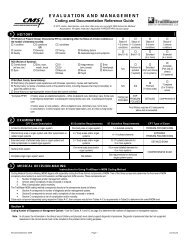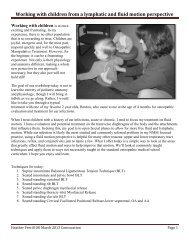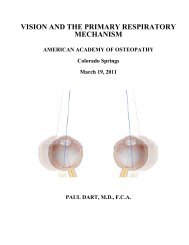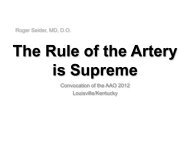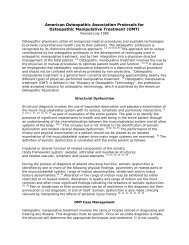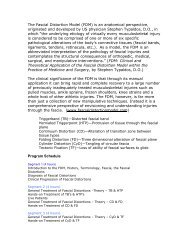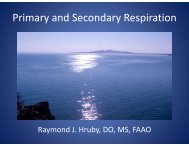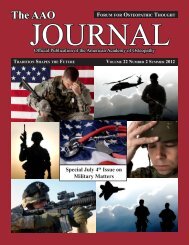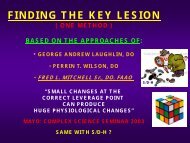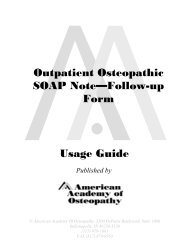(OMT) for Patients with Low Back Pain - American Academy of ...
(OMT) for Patients with Low Back Pain - American Academy of ...
(OMT) for Patients with Low Back Pain - American Academy of ...
You also want an ePaper? Increase the reach of your titles
YUMPU automatically turns print PDFs into web optimized ePapers that Google loves.
2a2b3aSystematic review <strong>with</strong> homogeneity <strong>of</strong>cohort studiesIndividual cohort study or low-qualityrandomized controlled trialSystematic review <strong>with</strong> homogeneity <strong>of</strong>case-control studiesIndividual studies should be free<strong>of</strong> substantial variations in thedirections and magnitudes <strong>of</strong><strong>OMT</strong> effects<strong>Low</strong> quality may be indicated bysuch factors as importantdifferences in baselinecharacteristics between groups,lack <strong>of</strong> concealment <strong>of</strong> treatmentallocation, and excessive lossesto follow-upIndividual studies should be free<strong>of</strong> substantial variations in thedirections and magnitudes <strong>of</strong><strong>OMT</strong> effects3b Individual case-control study These should be free <strong>of</strong>substantialevidence <strong>of</strong> selection bias,in<strong>for</strong>mation bias, orconfounding variables4 Case series and low quality cohort andcase-control studies5 Expert opinion <strong>with</strong>out explicit criticalappraisal, or based on physiology,bench research, or "first principles"<strong>Low</strong> quality <strong>of</strong> cohort and casecontrol studies may be indicatedby such factors as importantsources <strong>of</strong> selection bias,in<strong>for</strong>mation bias, orconfounding variablesThese generally will have limitedempirical data relevant to <strong>OMT</strong>effects in human populations*Adapted from Straus SE, Richardson WS, Glasziou P, and Haynes RB, Evidence-Based Medicine.How to Practice and Teach EBM (3rd ed), 200515. Potential benefits and harms: Describe anticipated benefits and potential risks associated <strong>with</strong>implementation <strong>of</strong> guideline recommendations.Potential benefits include but are not limited to improved care <strong>for</strong> patients seeing osteopathicphysicians or practitioners <strong>for</strong> somatic dysfunctions causing low back pain. Harms have not beenidentified in randomized clinical trials on <strong>OMT</strong> <strong>for</strong> patients <strong>with</strong> low back pain. <strong>OMT</strong> <strong>for</strong> somaticdysfunction has not demonstrated harm in any clinical trials to date.16. Patient preferences: Describe the role <strong>of</strong> patient preferences when a recommendation involves asubstantial element <strong>of</strong> personal choice or values.<strong>Patients</strong> have a choice <strong>of</strong> provider and services when they suffer from low back pain. <strong>OMT</strong> <strong>of</strong>fersanother option <strong>for</strong> care <strong>for</strong> low back pain from somatic dysfunction and can be provided by9
osteopathic physicians. It is utilized as an adjunct or complementary to conventional or alternativemethods <strong>of</strong> treatment.17. Algorithm: Provide (when appropriate) a graphical description <strong>of</strong> the stages and decisions inclinical care described by the guideline.Once a patient <strong>with</strong> low back pain is diagnosed <strong>with</strong> somatic dysfunction as the cause, orcontributing factor, <strong>of</strong> the low back pain, <strong>OMT</strong> should be utilized by the osteopathic physician. Thediagnosis <strong>of</strong> somatic dysfunction entails a focal or complete history and physical exam, including anosteopathic structural exam that provides evidence <strong>of</strong> asymmetrical anatomical landmarks,restriction or altered range <strong>of</strong> joint motion, and palpatory abnormalities <strong>of</strong> s<strong>of</strong>t tissues. <strong>OMT</strong> totreat somatic dysfunction is utilized after other potential causes <strong>of</strong> low back pain are ruled out orconsidered improbable by the treating physician; i.e., vertebral fracture; vertebral joint dislocation;muscle tears or lacerations; spinal or vertebral joint ligament rupture; inflammation <strong>of</strong> intervertebraldiscs, spinal zygapophyseal facets joints, muscles or fascia; skin lacerations; sacroiliitis; ankylosingspondylitis; masses in or from the low back structures; or organic (visceral) disease referring pain tothe back or causing low back muscle spasms.Algorithm <strong>for</strong> <strong>OMT</strong> LBP decision making.Adapted from: Chapter 4. “The manipulative prescription,” In: Somatic Dysfunction in OsteopathicFamily Medicine. Nelson, Glonek, eds., Baltimore, MD: Lippincott, Williams & Wilkins; 2007;27-32.Is Somatic dysfunction the cause,or a contributing factor, in thepresentation <strong>of</strong> LBP (Look <strong>for</strong> “RedFlags.”)YesCause:A) Define type <strong>of</strong> dysfunctionalmechanics and as appropriate, definethe dysfunctional barrier.NoIdentify cause <strong>of</strong> LBP andtreat accordingly.Contributing factor: Identifyprimary cause <strong>of</strong> LBP andtreat accordingly. Treatcontributing somaticdysfunction using the samedecision making as followed ifthe LBP is solely the result <strong>of</strong>somatic dysfunction.B) Determine why the dysfunction is present (e.g., articular, muscular, my<strong>of</strong>ascial,neuroreflex, membranous).C) Determine the patient’s level <strong>of</strong> tolerance <strong>for</strong> <strong>OMT</strong>.D) Decide upon the type <strong>of</strong> <strong>OMT</strong> to most effectively address thecause <strong>of</strong> the dysfunction <strong>with</strong> consideration <strong>for</strong> patient tolerance.10
E) Apply <strong>OMT</strong> to accomplish the desired response.F) Reassess the dysfunction and determine if and when follow‐upevaluation is necessary.Follow‐up, if appropriate, and repeat steps A‐F.18. Implementation considerations: Describe anticipated barriers to application <strong>of</strong> therecommendations. Provide reference to any auxiliary documents <strong>for</strong> providers or patients that areintended to facilitate implementation. Suggest review criteria <strong>for</strong> measuring changes in care when theguideline is implemented.One <strong>of</strong> the barriers to application <strong>of</strong> the recommendations cited by osteopathic physicians has beenpoor reimbursement <strong>for</strong> <strong>OMT</strong>. 61 However, Medicare has reimbursed osteopathic physicians <strong>for</strong> thisprocedure (ICD-9 code: 98926-9), <strong>for</strong> over 30 years. Many osteopathic physicians apparently donot utilize <strong>OMT</strong> in clinical practice due to a number <strong>of</strong> barriers, including time constraints, lack <strong>of</strong>confidence, loss <strong>of</strong> skill over time from disuse, and inadequate <strong>of</strong>fice space. 61 Some specialists, i.e.,pathologists and radiologists, do not use <strong>OMT</strong> as it is not applicable to their duties <strong>with</strong>in theirspecialty. The AOA believes patients <strong>with</strong> low back pain should be treated <strong>with</strong> <strong>OMT</strong> given the highlevel <strong>of</strong> evidence that supports its efficacy. Changes in care when this guideline is implemented willbe determined by physician and patient surveys, billing and coding practice patterns amongstosteopathic physicians, data gathered from osteopathic physicians via the AOA’s ClinicalAssessment Program, and other registry data gathering tools currently being developed byresearchers.REFERENCES1. Cypress BK: Characteristics <strong>of</strong> physician visits <strong>for</strong> back symptoms: a national perspective.<strong>American</strong> Journal <strong>of</strong> Public Health 1983, 73:389-395.2. Licciardone JC, Herron KM: Characteristics, satisfaction, and perceptions <strong>of</strong> patients receivingambulatory healthcare from osteopathic physicians: a comparative national survey. Journal <strong>of</strong> the<strong>American</strong> Osteopathic Association 2001, 101:374-385.3. Licciardone JC: Awareness and use <strong>of</strong> osteopathic physicians in the United States: results <strong>of</strong> theSecond Osteopathic Survey <strong>of</strong> Health Care in America (OSTEOSURV-II). Journal <strong>of</strong> the <strong>American</strong>Osteopathic Association 2003, 103:281-289.4. Bigos S, Bowyer O, Braen G, et al: Acute <strong>Low</strong> <strong>Back</strong> Problems in Adults. Clinical Practice Guideline No.14. Rockville, MD: Agency <strong>for</strong> Health Care Policy and Research, Public Health Service, USDepartment <strong>of</strong> Health and Human Services; 1994.5. Kuchera ML, DiGiovanna EL, Greenspan PE: Efficacy and complications. In Foundations <strong>for</strong>Osteopathic Medicine. 2nd edition. Edited by Ward RC. Philadelphia, PA: Lippincott Williams &Wilkins; 2003:1143-1152.11
6. Harvey E, Burton AK, M<strong>of</strong>fett JK, Breen A: Spinal manipulation <strong>for</strong> low-back pain: a treatmentpackage agreed by the UK chiropractic, osteopathy and physiotherapy pr<strong>of</strong>essional associations.Manual Therapy 2003, 8:46-51.7. UK BEAM Trial Team: United Kingdom back pain exercise and manipulation (UK BEAM)randomised trial: effectiveness <strong>of</strong> physical treatments <strong>for</strong> back pain in primary care. British MedicalJournal 2004, 329:1377-doi:10.1136/bmj.38282.669225.AE.8. UK BEAM Trial Team: United Kingdom back pain exercise and manipulation (UK BEAM)randomised trial: cost effectiveness <strong>of</strong> physical treatments <strong>for</strong> back pain in primary care. BritishMedical Journal 2004, 329:1381-doi:10.1136/bmj.38282.607859.AE.9. Lesho EP: An overview <strong>of</strong> osteopathic medicine. Archives <strong>of</strong> Family Medicine 1999, 8:477-484.10. Mein EA, Greenman PE, McMillin DL, Richards DG, Nelson CD: Manual medicine diversity:research pitfalls and the emerging medical paradigm. Journal <strong>of</strong> the <strong>American</strong> Osteopathic Association2001, 101:441-444.11. Balon J, Aker PD, Crowther ER, et al: A comparison <strong>of</strong> active and simulated chiropracticmanipulation as adjunctive treatment <strong>for</strong> childhood asthma. New England Journal <strong>of</strong> Medicine 1998,339:1013-20.12. Nelson CD, McMillin DL, Richards DG, Mein EA, Redwood D: Manual healingdiversity and other challenges to chiropractic integration. Journal <strong>of</strong> Manipulative andPhysiological Therapeutics 2000, 23:202-207.13. Bron<strong>for</strong>t G, Haas M, Evans RL, Bouter LM: Efficacy <strong>of</strong> spinal manipulation and mobilization<strong>for</strong> low back pain and neck pain: a systematic review and best evidence synthesis. The Spine Journal2004, 4:335-356.14. Howell JD: The paradox <strong>of</strong> osteopathy. New England Journal <strong>of</strong> Medicine 1999, 341:1465-1468.15. Ottenbacher K, DiFabio RP: Efficacy <strong>of</strong> spinal manipulation /mobilization therapy: a metaanalysis.Spine 1985, 10:833-837.16. Koes BW, Assendelft WJJ, van der Heijden GJMG, Bouter LM, Knipschild PG: Spinalmanipulation and mobilisation <strong>for</strong> back and neck pain: a blinded review. Britishm Medical Journal1991, 303:1298-1303.17. Abenhaim L, Bergeron AM: Twenty years <strong>of</strong> randomized clinical trials <strong>of</strong> manipulative therapy<strong>for</strong> back pain: a review. Clinical and Investigative Medicine 1992, 15:527-535.18. Anderson R, Meeker WC, Wirick BE, Mootz RD, Kirk DH, Adams A: A meta-analysis <strong>of</strong>clinical trials <strong>of</strong> spinal manipulation. Journal <strong>of</strong> Manipulative and Physiological Therapeutics 1992, 15:181-194.19. DiFabio RP: Efficacy <strong>of</strong> manual therapy. Physical Therapy 1992, 72:853-864.20. Shekelle PG, Adams AH, Chassin MR, Hurwitz EL, Brook RH: Spinal manipulation <strong>for</strong> lowbackpain. Annals <strong>of</strong> Internal Medicine 1992, 117:590-598.21. Scheer SJ, Radack KL, O'Brien DR: Randomized controlled trials in industrial low back painrelating to return to work. Part 1. Acute interventions. Archives <strong>of</strong> Physical Medicine and Rehabilitation1995, 76:966-973.22. Koes BW, Assendelft WJJ, van der Heijden GJMG, Bouter LM: Spinal manipulation <strong>for</strong> lowback pain: an updated systematic review <strong>of</strong> randomized clinical trials. Spine 1996, 21:2860-2873.23. Scheer SJ, Radack KL, O'Brien DR: Randomized controlled trials in industrial low back painrelating to return to work. Part 2. Discogenic low back pain. Archives <strong>of</strong> Physical Medicine andRehabilitation 1996, 77:1189-1197.24. Scheer SJ, Watanabe TK, Radack KL: Randomized controlled trials in industrial low back pain.Part 3. Subacute/chronic pain interventions. Archives <strong>of</strong> Physical Medicine and Rehabilitation 1997,78:414-423.12
25. van der Weide WE, Verbeek JHAM, van Tulder MW: Vocational outcome <strong>of</strong> intervention <strong>for</strong>low-back pain. Scandinavian Journal <strong>of</strong> Work, Environment and Health 1997, 23:165-178.26. van Tulder MW, Koes BW, Bouter LM: Conservative treatment <strong>of</strong> acute and chronicnonspecific low back pain: a systematic review <strong>of</strong> randomized controlled trials <strong>of</strong> the most commoninterventions. Spine 1997, 22:2128-2156.27. Bron<strong>for</strong>t G: Spinal manipulation: current state <strong>of</strong> research and its indications. Neurologic Clinics <strong>of</strong>North America 1999, 17:91-111.28. Ernst E, Harkness E: Spinal manipulation: a systematic review <strong>of</strong> sham controlled, double-blind,randomized clinical trials. Journal <strong>of</strong> <strong>Pain</strong> and Symptom Management 2001, 22:879-889.29. Ferreira ML, Ferreira PH, Latimer J, Herbert R, Maher CG: Does spinal manipulative therapyhelp people <strong>with</strong> chronic low back pain? Australian Journal <strong>of</strong> Physiotherapy 2002, 48:277-284.30. Pengel HM, Maher CG, Refshauge KM: Systematic review <strong>of</strong> conservative interventions <strong>for</strong>subacute low back pain. Clinical Rehabilitation 2002, 16:811-820.31. Assendelft WJJ, Morton SC, Yu EI, Suttorp MJ, Shekelle PG: Spinal manipulative therapy <strong>for</strong>low back pain: a meta-analysis <strong>of</strong> effectiveness relative to other therapies. Annals <strong>of</strong> Internal Medicine2003, 138:871-881.32. Cherkin DC, Sherman KJ, Deyo RA, Shekelle PG: A review <strong>of</strong> the evidence <strong>for</strong> theeffectiveness, safety, and cost <strong>of</strong> acupuncture, massage therapy, and spinal manipulation <strong>for</strong> backpain. Annals <strong>of</strong> Internal Medicine 2003, 138:898-906.33. Haldeman S, Hooper PD, Phillips RB, Scaringe JG, Traina AD: Spinal manipulative therapy. InThe Adult Spine: Principles and Practice. 2nd edition. Edited by Frymoyer JW. Philadelphia, PA:Lippincott-Raven Publishers; 1997:1837-1861.34. Siehl D, Olson DR, Ross HE, Rockwood EE: Manipulation <strong>of</strong> the lumbar spine <strong>with</strong> the patientunder general anesthesia: evaluation by electromyography and clinical neurologic examination <strong>of</strong> itsuse <strong>for</strong> lumbar nerve root compression syndrome. Journal <strong>of</strong> the <strong>American</strong> Osteopathic Association 1971,70:433-440.35. Doran DML, Newell DJ: Manipulation in treatment <strong>of</strong> low back pain: a multicentre study. BritishMedical Journal 1975, 2:161-164.36. Hadler NM, Curtis P, Gillings DB, Stinnett S: A benefit <strong>of</strong> spinal manipulation as adjunctivetherapy <strong>for</strong> acute low-back pain: a stratified controlled trial. Spine 1987, 12:703-706.37. Ellestad SM, Nagle RV, Boesler DR, Kilmore MA: Electromyographic and skin resistanceresponses to osteopathic manipulative treatment <strong>for</strong> low-back pain. Journal <strong>of</strong> the <strong>American</strong> OsteopathicAssociation 1988, 88:991-997.38. MacDonald RS, Bell CMJ: An open controlled assessment <strong>of</strong> osteopathic manipulation innonspecific low-back pain. Spine 1990, 15:364-370.39. Boesler D, Warner M, Alpers A, Finnerty EP, Kilmore MA: Efficacy <strong>of</strong> high velocity lowamplitudemanipulative technique in subjects <strong>with</strong> low-back pain during menstrual cramping. Journal<strong>of</strong> the <strong>American</strong> Osteopathic Association 1993, 93:203-214.40. H<strong>of</strong>fman KS, H<strong>of</strong>fman LL: Effects <strong>of</strong> adding sacral base leveling to osteopathic manipulativetreatment <strong>of</strong> back pain: a pilot study. Journal <strong>of</strong> the <strong>American</strong> Osteopathic Association 1994, 94:217-226.41. Patterson MM: Foundations <strong>for</strong> osteopathic medical research. In Foundations <strong>for</strong> OsteopathicMedicine. 2nd edition. Edited by Ward RC. Philadelphia, PA: LippincottWilliams & Wilkins; 2003:1167-1187.42. Hoehler FK, Tobis JS, Buerger AA: Spinal manipulation <strong>for</strong> low back pain. Journal <strong>of</strong> the <strong>American</strong>Medical Association 1981, 245:1835-1838.43. Gibson T, Grahame R, Harkness J, Woo P, Blagrave P, Hills R: Controlled comparison <strong>of</strong> shortwavediathermy treatment <strong>with</strong> osteopathic treatment in nonspecific low back pain. Lancet 1985,1:1258-1261.13
44. Andersson GBJ, Lucente T, Davis AM, Kappler RE, Lipton JA, Leurgans S: A comparison <strong>of</strong>osteopathic spinal manipulation <strong>with</strong> standard care <strong>for</strong> patients <strong>with</strong> low back pain. New EnglandJournal <strong>of</strong> Medicine 1999, 341:1426-1431.45. Burton AK, Tillotson KM, Cleary J: Single-blind randomised controlled trial <strong>of</strong>chemonucleolysis and manipulation in the treatment <strong>of</strong> symptomatic lumbar disc herniation.European Spine Journal 2000, 9:202-207.46. Licciardone JC, Stoll ST, Fulda KG, Russo DP, Siu J, Winn W, Swift J: Osteopathic manipulativetreatment <strong>for</strong> chronic low back pain: a randomized controlled trial. Spine 2003, 28:1355-1362.47 Cleary C, Fox JP: Menopausal symptoms: an osteopathic investigation. Complementary Therapies inMedicine 1994, 2:181-186.48. Williams NH, Wilkinson C, Russell I, Edwards RT, Hibbs R, Linck P, Muntz R: Randomizedosteopathic manipulation study (ROMANS): pragmatic trial <strong>for</strong> spinal pain in primary care. FamilyPractice 2003, 20:662-669.49. Ernst E: Another negative trial <strong>of</strong> manipulative treatment <strong>for</strong> back pain. Focus on Alternative andComplementary Therapies 2004, 9:43-44.50. Margo K: Cochrane <strong>for</strong> clinicians: Putting evidence into practice. Spinal manipulative therapy <strong>for</strong>low back pain. <strong>American</strong> Family Physician 2005, 71:464-465.51. Rosenthal R: Parametric measures <strong>of</strong> effect size. In The Handbook <strong>of</strong> Research Synthesis. Edited byCooper H, Hedges LV. New York, NY: Russell Sage Foundation; 1994:231-244.52. Hedges LV, Olkin I: Statistical Methods <strong>for</strong> Meta-Analysis. Boston, MA: AcademicPress, Inc; 1985.53. Hróbjartsson A, Gøtzsche PC: Is the placebo powerless? An analysis <strong>of</strong> clinical trials comparingplacebo <strong>with</strong> no treatment. New England Journal <strong>of</strong> Medicine 2001, 344:1594-1602.54. Ernst E: Does spinal manipulation have specific treatment effects? Family Practice 2000, 17:554-556.55. Bjordal JM, Ljunggren AE, Klovning A, Slørdal L: Non-steroidal anti-inflammatory drugs,including cyclo-oxygenase-2 inhibitors, in osteoarthritic knee pain: meta-analysis <strong>of</strong> randomisedplacebo controlled trials. British Medical Journal 2004, 329:1317-doi:10.1136/bmj.38273.626655.63.56. Reilly BM, Hart A, Evans AT: Part II. Evidence-based medicine: a passing fancy or the future <strong>of</strong>primary care? Disease-a-Month 1998, 44:370-399.57. Shekelle PG, Markovich M, Louie R: Factors associated <strong>with</strong> choosing a chiropractor <strong>for</strong>episodes <strong>of</strong> back pain care. Medical Care 1995, 33:842-850.58. Hart LG, Deyo RA, Cherkin DC: Physician <strong>of</strong>fice visits <strong>for</strong> low back pain: frequency, clinicalevaluation, and treatment patterns from a U.S. national survey. Spine 1995, 20:11-19.59. Wolf FM: Meta-Analysis: Quantitative Methods <strong>for</strong> Research Synthesis. Quantitative Applications inthe Social Sciences. Newbury Park, CA: Sage Publications, 07-059; 1986.60. Bombardier C: Outcome assessments in the evaluation <strong>of</strong> treatment <strong>of</strong> spinal disorders:summary and general recommendations. Spine 2000, 25:3100-3103.61. Johnson SM, Kurtz ME, Kurtz JC: Variables influencing the use <strong>of</strong> osteopathic manipulativetreatment in family practice. J Am Osteopath Assoc. 1997 Feb;97(2):80-7. Erratum in: J AmOsteopath Assoc 1997 Apr;97(4):202.14
Appendix 1COMPUTERIZED DATABASE SEARCH STRATEGIESA literature search <strong>for</strong> all patient-oriented research involving osteopathic manipulative treatment hasbeen conducted in the following databases: MEDLINE, OLDMEDLINE, OSTMED, AMED,MANTIS, CINAHL, EMBASE, and Cochrane Center Register <strong>of</strong> Controlled Trials. The followingthesis and dissertation databases and websites have been searched: Osteopathic Research Web,WorldCat Dissertations and Theses, and Digital Dissertation Abstracts, Canadian College <strong>of</strong>Osteopathy Research Titles, and the International <strong>Academy</strong> <strong>of</strong> Osteopathy.Search strategy <strong>for</strong> MEDLINE:1. Manipulation, osteopathic (MeSH)2. <strong>OMT</strong> (text word)3. Osteopathic medicine (MeSH)4. 1 or 2 or 35. Biomedical Research (MeSH)6. Clinical Trials (MeSH)7. Randomized Control Trials (MeSH)8. Epidemiologic Studies (MeSH)9. 5 or 6 or 7 or 810. 4 and 911. Limit 10 to human12. Manual Therapy (text word)13. Manual Medicine (text word)14. 12 or 1315. 14 and 916. Limit 15 to humanSearch strategy <strong>for</strong> OLDMEDLINE1. Osteopath2. Osteopathy3. Osteopathic Medicine4. 1 or 2 or 35. Research6. Clinical Trials7. Epidemiologic Studies8. 5 or 6 or 79. 4 and 810. Limit 9 to humanSearch strategy <strong>for</strong> OSTMED® (OSTMED.DR®)15
1. Osteopathic Medicine2. Manipulation, Osteopathic3. <strong>OMT</strong>4. 1 or 2 or 35. Biomedical Research6. Clinical Trials7. Epidemiologic Studies8. 5 or 6 or 79. 4 and 810. Limit 9 to humanSearch strategy <strong>for</strong> AMED and MANTIS1. Osteopathy2. Manipulation, Osteopathic3. 1 or 24. Clinical Trials5. Research6. 4 or 57. 3 and 68. Limit 7 to humanSearch strategy <strong>for</strong> CINAHL1. Osteopathy2. Manipulation, Osteopathic3. Medicine, Osteopathic4. 1 or 2 or 35. Clinical Trials6. Research7. 4 or 58. 4 and 69. Limit 7 to humanSearch strategy <strong>for</strong> EMBASE (where ? is a truncation symbol)10. Osteopath? And manipulat? AND (clinical OR patient AND research)11. <strong>OMT</strong> AND (clinical OR patient AND research)12. Osteopath? AND manipulat? AND epidemiolog?(w)stud?13. <strong>OMT</strong> AND epidemiolog?(w)stud?14. Limit to humanSearch strategy <strong>for</strong> Cochrane Center Register <strong>of</strong> Controlled Trials1. Osteopath$ (where $ is a truncation symbol)2. <strong>OMT</strong>3. 1 or 216
Search strategy <strong>for</strong> the Osteopathic Research Web and WorldCat Dissertationsand Theses1. Osteopathic OR <strong>OMT</strong>2. AND research OR study OR trial3. Order by “Date Descending”Search strategy <strong>for</strong> the Canadian College <strong>of</strong> Osteopathy Research Titles and theInternational <strong>Academy</strong> <strong>of</strong> Osteopathy1. Scanning research web pages <strong>for</strong> appropriate titles and abstractsList <strong>of</strong> osteopathic core journals utilized at the Gibson D. Lewis Health Sciences LibraryUniversity <strong>of</strong> North Texas Health Science CenterAAO JournalACOEP NewsletterAOMA DigestAustralasian Chiropractic & OsteopathyAustralasian Osteopathic Medicine ReviewAustralian Journal <strong>of</strong> OsteopathyBritish Osteopathic JournalChiropractic & OsteopathyClinical BiomechanicsClinical Journal <strong>of</strong> Doctors HospitalsClinical Journal <strong>of</strong> Sports MedicineCompendiumCranial Letter (and all variant titles)DODO Net GuideHawkeye Osteopathic JournalHealth: An Osteopathic PublicationJournal <strong>of</strong> Osteopathic EducationJournal <strong>of</strong> Osteopathic Education & Clinical PracticeJournal <strong>of</strong> Osteopathic Medicine (JOM)Journal <strong>of</strong> Osteopathic Sports MedicineJournal <strong>of</strong> OsteopathyJournal <strong>of</strong> Podiatric MedicineJournal <strong>of</strong> the <strong>American</strong> Osteopathic AssociationJournal <strong>of</strong> the <strong>American</strong> Osteopathic College <strong>of</strong> DermatologistsJournal <strong>of</strong> the <strong>American</strong> Osteopathic Colleges <strong>of</strong> Ophthalmology & Otolaryngology (variant titles)Journal <strong>of</strong> the Osteopathic Physicians & Surgeons <strong>of</strong> Cali<strong>for</strong>niaJournal <strong>of</strong> the Pennsylvania Osteopathic Medical AssociationMaternal & Child HealthMichigan Osteopathic Journal (and variant titles)Newsletter <strong>of</strong> the <strong>American</strong> Osteopathic College <strong>of</strong> Anesthesiologists17
NJAOPS JournalOhio Research & Clinical ReviewOrthopod (and variant titles)OsteopathOsteopathic AnnalsOsteopathic Family Physician News (and variant titles)Osteopathic InternistOsteopathic Journal <strong>of</strong> Obstetrics & GynecologyOsteopathic MagazineOsteopathic Medical NewsOsteopathic MedicineOsteopathic NewsOsteopathic PhysicianOsteopathic Pr<strong>of</strong>essionOsteopathic SymposiumOsteopathische MedizinOsteopathy TodayTexas Osteopathic Physicians JournalYearbook <strong>of</strong> the <strong>American</strong> <strong>Academy</strong> <strong>of</strong> Osteopathy18
Appendix 2DEFINITION OF TERMS USEDGlossary <strong>of</strong> Osteopathic Terminology, Revised April 2009. Reprinted <strong>with</strong> permission from the<strong>American</strong> Association <strong>of</strong> Colleges <strong>of</strong> Osteopathic Medicine. All rights reserved.Osteopathic Manipulative Treatment (<strong>OMT</strong>): The therapeutic application <strong>of</strong> manually guided<strong>for</strong>ces by an osteopathic physician (US Usage) to improve physiologic function and/or supporthomeostasis that has been altered by somatic dysfunction. <strong>OMT</strong> employs a variety <strong>of</strong> techniquesincluding, but not limited to:active method, technique in which the person voluntarily per<strong>for</strong>ms an osteopathicpractitioner-directed motion.articulatory treatment, (archaic). See osteopathic manipulative treatment, articulatory treatmentsystem.articulatory treatment system (ART), a low velocity/moderate to high amplitudetechnique where a joint is carried through its full motion <strong>with</strong> the therapeutic goal <strong>of</strong>increased range <strong>of</strong> movement. The activating <strong>for</strong>ce is either a repetitive springing motion orrepetitive concentric movement <strong>of</strong> the joint through the restrictive barrier.balanced ligamentous tension (BLT), 1. According to Sutherland’s model, all the joints inthe body are balanced ligamentous articular mechanisms. The ligaments provideproprioceptive in<strong>for</strong>mation that guides the muscle response <strong>for</strong> positioning the joint and theligaments themselves guide the motion <strong>of</strong> the articular components. (Foundations) 2. Firstdescribed in “Osteopathic Technique <strong>of</strong> William G. Sutherland”, that was published in the1949 Year Book <strong>of</strong> <strong>Academy</strong> <strong>of</strong> Applied Osteopathy. See also ligamentous articular strain.Chapman reflex, See Chapman reflex.combined method, 1. A treatment strategy where the initial movements are indirect; as thetechnique is completed the movements change to direct <strong>for</strong>ces. 2. A manipulative sequenceinvolving two or more different osteopathic manipulative treatment systems (e.g., Spencertechnique combined <strong>with</strong> muscle energy technique). 3. A concept described by PaulKimberly, DO.combined treatment, (archaic). See osteopathic manipulative treatment, combined method.compression <strong>of</strong> the fourth ventricle (CV-4), a cranial technique in which the lateral angles<strong>of</strong> the occipital squama are manually approximated slightly exaggerating the posteriorconvexity <strong>of</strong> the occiput and taking the cranium into sustained extension.counterstrain (CS), 1. A system <strong>of</strong> diagnosis and treatment that considers the dysfunctionto be a continuing, inappropriate strain reflex, which is inhibited by applying a position <strong>of</strong>mild strain in the direction exactly opposite to that <strong>of</strong> the reflex; this is accomplished by19
specific directed positioning about the point <strong>of</strong> tenderness to achieve the desired therapeuticresponse. 2. Australian and French use: Jones technique, (correction spontaneous byposition), spontaneous release by position. 3. Developed by Lawrence Jones, DO in 1955(originally “Spontaneous Release by Positioning,” later termed “strain-counterstrain”).cranial treatment (CR), See primary respiratory mechanism. See osteopathy in the cranial field.CV-4, Abbreviation <strong>for</strong> compression <strong>of</strong> the fourth ventricle. See osteopathic manipulativetreatment, compression <strong>of</strong> the fourth ventricle.Dalrymple treatment, See osteopathic manipulative treatment, pedal pump.direct method (D/DIR), an osteopathic treatment strategy by which the restrictive barrieris engaged and a final activating <strong>for</strong>ce is applied to correct somatic dysfunction.exaggeration method, an osteopathic treatment strategy by which the dysfunctionalcomponent is carried away from the restrictive barrier and beyond the range <strong>of</strong> voluntarymotion to a point <strong>of</strong> palpably increased tension.exaggeration technique, an indirect procedure that involves carrying the dysfunctional partaway from the restrictive barrier, then applying a high velocity/low amplitude <strong>for</strong>ce in thesame direction.facilitated oscillatory release technique (FOR), 1. A technique intended to normalizeneuromuscular function by applying a manual oscillatory <strong>for</strong>ce, which may be combined<strong>with</strong> any other ligamentous or my<strong>of</strong>ascial technique. 2. A refinement <strong>of</strong> a long-standing use<strong>of</strong> oscillatory <strong>for</strong>ce in osteopathic diagnosis and treatment as published in early osteopathicliterature. 3. A technique developed by Zachary Comeaux, DO.facilitated positional release (FPR), a system <strong>of</strong> indirect my<strong>of</strong>ascial release treatment. Thecomponent region <strong>of</strong> the body is placed into a neutral position, diminishing tissue and jointtension in all planes, and an activating <strong>for</strong>ce (compression or torsion) is added. 2. Atechnique developed by Stanley Schiowitz, DO.fascial release treatment, See osteopathic manipulative treatment, my<strong>of</strong>ascial release.fascial unwinding, a manual technique involving constant feedback to the osteopathicpractitioner who is passively moving a portion <strong>of</strong> the patient’s body in response to thesensation <strong>of</strong> movement. Its <strong>for</strong>ces are localized using the sensations <strong>of</strong> ease and bind overwider regions.functional method, an indirect treatment approach that involves finding the dynamicbalance point and one <strong>of</strong> the following: applying an indirect guiding <strong>for</strong>ce, holding theposition or adding compression to exaggerate position and allow <strong>for</strong> spontaneousreadjustment. The osteopathic practitioner guides the manipulative procedure while thedysfunctional area is being palpated in order to obtain a continuous feedback <strong>of</strong> thephysiologic response to induced motion. The osteopathic practitioner guides the20
abdominal contents are compressed to enhance venous and lymphatic drainage from thebowel.muscle energy, a <strong>for</strong>m <strong>of</strong> osteopathic manipulative diagnosis and treatment in which thepatient’s muscles are actively used on request, from a precisely controlled position, in aspecific direction and against a distinctly executed physician counter<strong>for</strong>ce. First described in1948 by Fred Mitchell, Sr, DO.my<strong>of</strong>ascial release (MFR), a system <strong>of</strong> diagnosis and treatment first described by AndrewTaylor Still and his early students, which engages continual palpatory feedback to achieverelease <strong>of</strong> my<strong>of</strong>ascial tissues.direct MFR, a my<strong>of</strong>ascial tissue restrictive barrier is engaged <strong>for</strong> the my<strong>of</strong>ascial tissues andthe tissue is loaded <strong>with</strong> a constant <strong>for</strong>ce until tissue release occurs.indirect MFR, the dysfunctional tissues are guided along the path <strong>of</strong> least resistance untilfree movement is achieved.my<strong>of</strong>ascial technique, any technique directed at the muscles and fascia. See also osteopathicmanipulative treatment, my<strong>of</strong>ascial release. See also osteopathic manipulative treatment, s<strong>of</strong>t tissuetechnique.myotension, a system <strong>of</strong> diagnosis and treatment that uses muscular contractions andrelaxations under resistance <strong>of</strong> the osteopathic practitioner to relax, strengthen or stretchmuscles, or mobilize joints.Osteopathy in the Cranial Field (OCF), 1. A system <strong>of</strong> diagnosis and treatment by anosteopathic practitioner using the primary respiratory mechanism and balanced membranoustension. See also primary respiratory mechanism. 2. Refers to the system <strong>of</strong> diagnosis andtreatment first described by William G. Sutherland, DO. 3. Title <strong>of</strong> reference work byHarold Magoun, Sr, DO.passive method, based on techniques in which the patient refrains from voluntary musclecontraction.pedal pump, a venous and lymphatic drainage technique applied through the lowerextremities; also called the pedal fascial pump or Dalrymple treatment.percussion vibrator technique, 1. A manipulative technique involving the specificapplication <strong>of</strong> mechanical vibratory <strong>for</strong>ce to treat somatic dysfunction. 2. An osteopathicmanipulative technique developed by Robert Ful<strong>for</strong>d, DO.positional technique, a direct segmental technique in which a combination <strong>of</strong> leverage,patient ventilatory movements and a fulcrum are used to achieve mobilization <strong>of</strong> thedysfunctional segment. May be combined <strong>with</strong> springing or thrust technique.22
progressive inhibition <strong>of</strong> neuromuscular structures (PINS), 1. A system <strong>of</strong> diagnosisand treatment in which the osteopathic practitioner locates two related points andsequentially applies inhibitory pressure along a series <strong>of</strong> related points. 2. Developed byDennis Dowling, DO.range <strong>of</strong> motion technique, active or passive movement <strong>of</strong> a body part to its physiologicor anatomic limit in any or all planes <strong>of</strong> motion.s<strong>of</strong>t tissue (ST), A system <strong>of</strong> diagnosis and treatment directed toward tissues other thanskeletal or arthrodial elements.s<strong>of</strong>t tissue technique, a direct technique that usually involves lateral stretching, linearstretching, deep pressure, traction and/or separation <strong>of</strong> muscle origin and insertion whilemonitoring tissue response and motion changes by palpation. Also called my<strong>of</strong>ascialtreatment.Spencer technique, a series <strong>of</strong> direct manipulative procedures to prevent or decrease s<strong>of</strong>ttissue restrictions about the shoulder. See also osteopathic manipulative treatment (<strong>OMT</strong>),articulatory treatment (ART).splenic pump technique, rhythmic compression applied over the spleen <strong>for</strong> the purpose <strong>of</strong>enhancing the patient’s immune response. See also osteopathic manipulative treatment (<strong>OMT</strong>),lymphatic pump.spontaneous release by positioning, See osteopathic manipulative treatment, counterstrain.springing technique, a low velocity/moderate amplitude technique where the restrictivebarrier is engaged repeatedly to produce an increased freedom <strong>of</strong> motion. See also osteopathicmanipulative treatment, articulatory treatment system.Still Technique, 1. Characterized as a specific non-repetitive articulatory method that isindirect then direct. 2. Attributed to A.T. Still. 3. A term coined by Richard Van Buskirk,DO, PhD.Strain-Counterstrain®, An osteopathic system <strong>of</strong> diagnosis and indirect treatment in whichthe patient’s somatic dysfunction, diagnosed by (an) associated my<strong>of</strong>ascial tenderpoint(s), istreated by using a passive position, resulting in spontaneous tissue release and at least 70percent decrease in tenderness. 2). Developed by Lawrence H. Jones, DO, in 1955. Seeosteopathic treatments, counterstrain.thoracic pump, 1. A technique that consists <strong>of</strong> intermittent compression <strong>of</strong> the thoraciccage. 2. Developed by C. Earl Miller, DOthrust technique (HVLA), See osteopathic manipulative treatment, high velocity/low amplitudetechnique (HVLA).toggle technique, short lever technique using compression and shearing <strong>for</strong>ces.23
traction technique, a procedure <strong>of</strong> high or low amplitude in which the parts are stretchedor separated along a longitudinal axis <strong>with</strong> continuous or intermittent <strong>for</strong>ce.v-spread, technique using <strong>for</strong>ces transmitted across the diameter <strong>of</strong> the skull to accomplishsutural gapping.ventral techniques, See osteopathic manipulative treatment, visceral manipulation.visceral manipulation (VIS), a system <strong>of</strong> diagnosis and treatment directed to the viscera toimprove physiologic function. Typically, the viscera are moved toward their fascialattachments to a point <strong>of</strong> fascial balance. Also called ventral techniques.Somatic dysfunction: Impaired or altered function <strong>of</strong> related components <strong>of</strong> the somatic (bodyframework) system: skeletal, arthrodial and my<strong>of</strong>ascial structures, and their related vascular,lymphatic, and neural elements. Somatic dysfunction is treatable using osteopathic manipulativetreatment.24


